AMD FX-8320E CPU Review: The Other 95W Vishera
by Ian Cutress on January 13, 2015 10:00 AM ESTCPU Benchmarks
The dynamics of CPU Turbo modes, both Intel and AMD, can cause concern during environments with a variable threaded workload. There is also an added issue of the motherboard remaining consistent, depending on how the motherboard manufacturer wants to add in their own boosting technologies over the ones that Intel would prefer they used. In order to remain consistent, we implement an OS-level unique high performance mode on all the CPUs we test which should override any motherboard manufacturer performance mode.
HandBrake v0.9.9: link
For HandBrake, we take two videos (a 2h20 640x266 DVD rip and a 10min double UHD 3840x4320 animation short) and convert them to x264 format in an MP4 container. Results are given in terms of the frames per second processed, and HandBrake uses as many threads as possible.
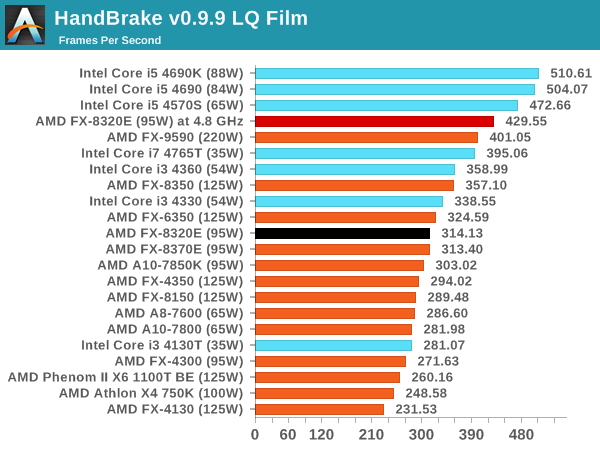
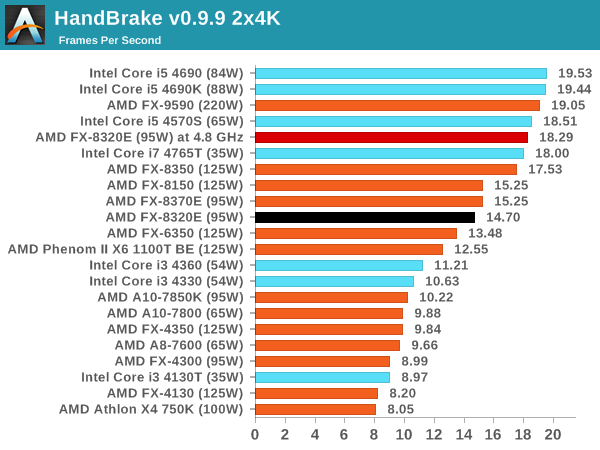
For Low Quality conversion, the 8320E has trouble keeping up with the full-fat i3, but beats them by a good margin when the frame sizes open up.
Dolphin Benchmark: link
Many emulators are often bound by single thread CPU performance, and general reports tended to suggest that Haswell provided a significant boost to emulator performance. This benchmark runs a Wii program that raytraces a complex 3D scene inside the Dolphin Wii emulator. Performance on this benchmark is a good proxy of the speed of Dolphin CPU emulation, which is an intensive single core task using most aspects of a CPU. Results are given in minutes, where the Wii itself scores 17.53 minutes.
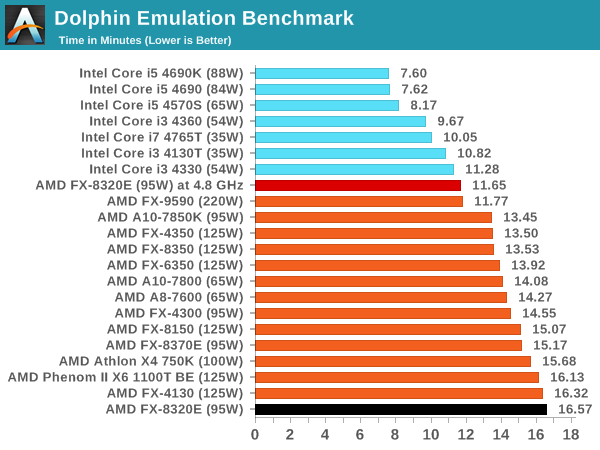
Dolphin historically prefers high IPC single core performance, which the 8320E is lacking.
WinRAR 5.0.1: link
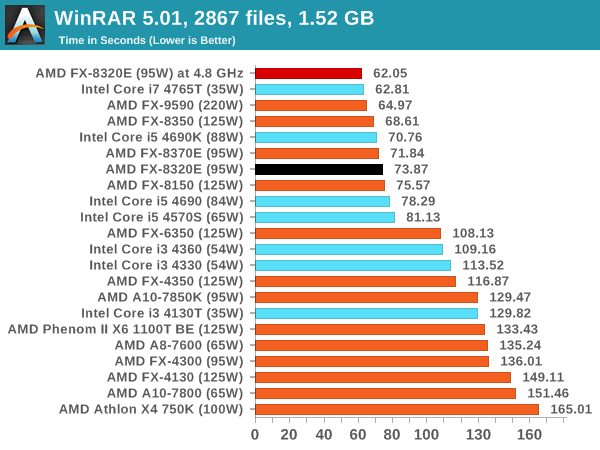
The eight threads of the FX-8000 series show through here, beating all the i3 and some of our i5 parts.
PCMark8 v2 OpenCL
A new addition to our CPU testing suite is PCMark8 v2, where we test the Work 2.0 suite in OpenCL mode.
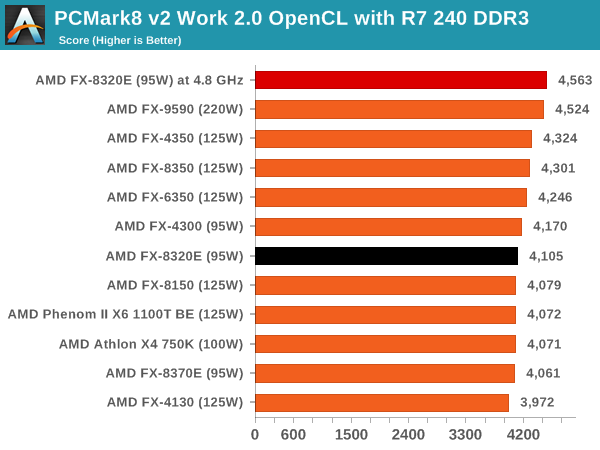
Hybrid x265
Hybrid is a new benchmark, where we take a 4K 1500 frame video and convert it into an x265 format without audio. Results are given in frames per second.
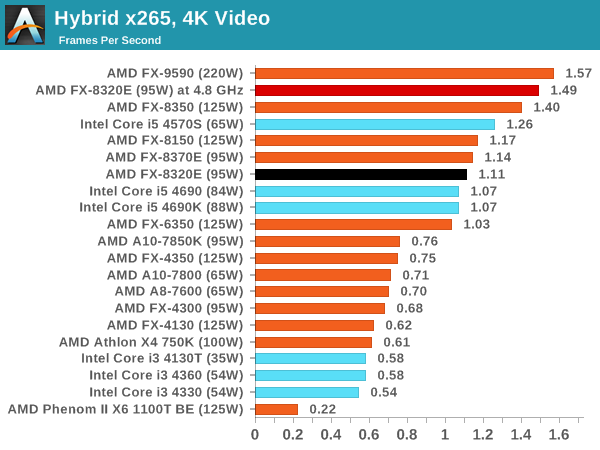
For x265 conversion those extra threads end up highly beneficial for the FX-8320E, nudging inbetween our i5 data.
3D Particle Movement
3DPM is a self-penned benchmark, taking basic 3D movement algorithms used in Brownian Motion simulations and testing them for speed. High floating point performance, MHz and IPC wins in the single thread version, whereas the multithread version has to handle the threads and loves more cores. For a brief explanation of the platform agnostic coding behind this benchmark, see my forum post here.
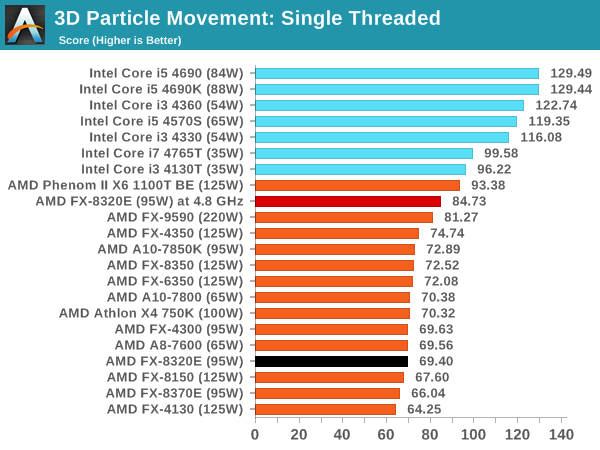
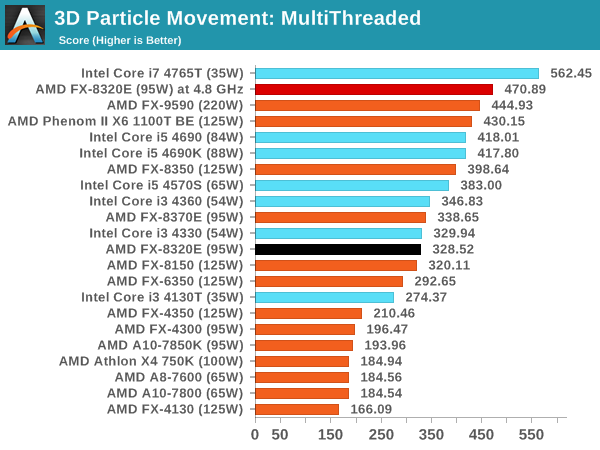
While single thread performance is behind, the overclocked FX-8320E storms ahead of our FX-9590 results.
FastStone Image Viewer 4.9
FastStone is the program I use to perform quick or bulk actions on images, such as resizing, adjusting for color and cropping. In our test we take a series of 170 images in various sizes and formats and convert them all into 640x480 .gif files, maintaining the aspect ratio. FastStone does not use multithreading for this test, and results are given in seconds.
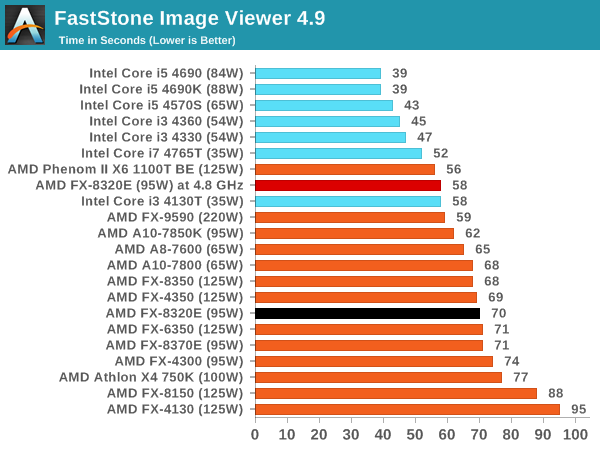
Web Benchmarks
On the lower end processors, general usability is a big factor of experience, especially as we move into the HTML5 era of web browsing. For our web benchmarks, we take four well known tests with Chrome 35 as a consistent browser.
Sunspider 1.0.2
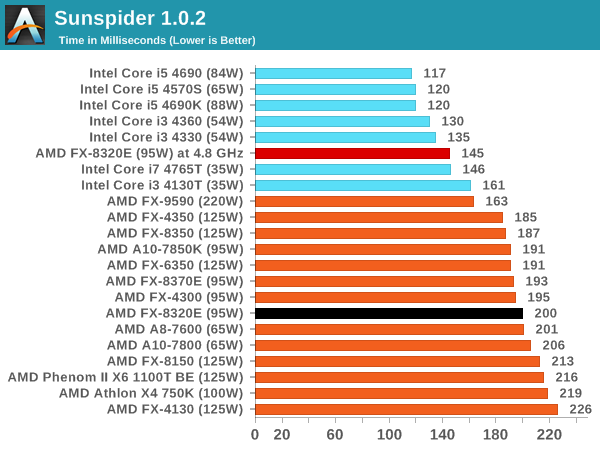
Mozilla Kraken 1.1
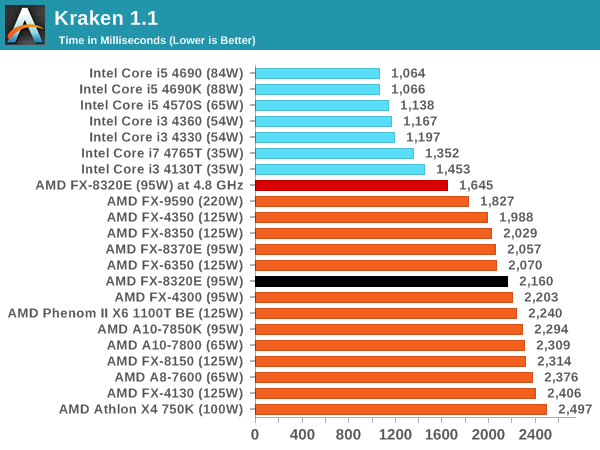
WebXPRT
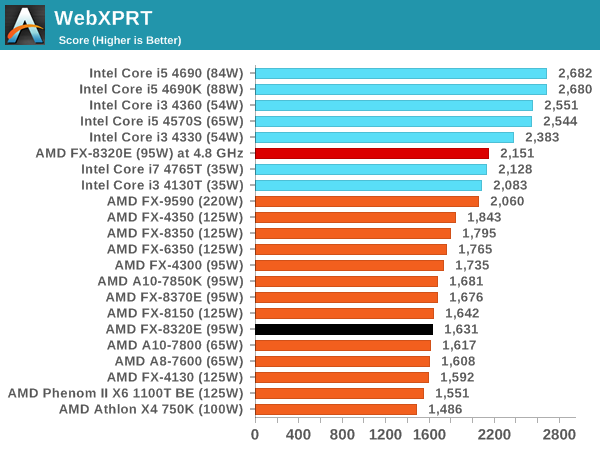
Google Octane v2
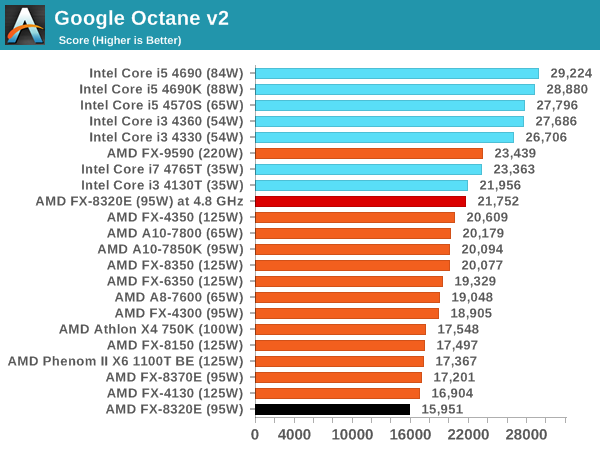










92 Comments
View All Comments
ExarKun333 - Tuesday, January 13, 2015 - link
Yeah, who needs PCIe 3.0, M.2 drives, etc? LOLroyalcrown - Tuesday, January 13, 2015 - link
M.2 is kind of dumb, stuff should just hurry up and migrate to pcieYukaKun - Tuesday, January 13, 2015 - link
You're not serious, right?The only real thing that the 990FX chipset needs is more USB3 ports and that's about it. I don't remember if the NB needs "DDR4 support" of some kind. Maybe extra interconnect logic.
PCIe 3.0 is not relevant right now since PCIe 2.0 is still enough. And not even with 3 or 4 cards in tandem, PCIe 3.0 is justifiable as a "required feature". M.2 drives... I don't even know why it is something you'd want in a desktop PC.
Cheers!
postem - Tuesday, January 13, 2015 - link
All while z97 chipset forces you to scale down PCI for every device you plug in.Intel forces chipset/socket every 2 years to force you buy new motherboards, its part of their game with their partners.
I really wish to go back to AMD, but ATM there is really not a reasonable performance cpu on their line and i really doubt will be any on foresee future.
Samus - Tuesday, January 13, 2015 - link
Intel actually launched the 90-series chipset 9 months after the 80-series. Granted, all rev C0 and newer 80-series run any CPU the 90-series does, but a lot of first adopters of the H81/H87/Z87 got screwed into no upgrade path.I agree, M2 in the desktop makes zero sense, and PCIe 3.0 is useless and will be for years. Most GPU's don't even utilize the full bandwidth of PCIe 2.0 8x.
As I said, Intel could think a little more forward (they're capable of doing so) but I think the marketing and bureaucratic politics are making the engineers push chipsets like there's no tomorrow. Intel actually makes as much selling chipsets as they do selling entry-level CPU's.
hojnikb - Tuesday, January 13, 2015 - link
>The only real thing that the 990FX chipset needs is more USB3 ports and that's about it. I don't remember if the NB needs "DDR4 support" of some kind. Maybe extra interconnect logic.Not more. 990FX doesn't even have any kind of native usb3 at all. All you see is 3rd party support via asmedia or similar chips.
So yeah, amd needs native usb3 and pcie 3.0 on their chipsets.
silverblue - Tuesday, January 13, 2015 - link
Assuming there's demand, AMD should look producing the 970 in 32nm (GF must have some spare capacity, surely?). Throw in native USB3 and halve chipset power consumption all at the same time. A 970A, if you will.hojnikb - Tuesday, January 13, 2015 - link
they never gonna do that.III-V - Tuesday, January 13, 2015 - link
>PCIe 3.0 is not relevant right now since PCIe 2.0 is still enough. And not even with 3 or 4 cards in tandem, PCIe 3.0 is justifiable as a "required feature". M.2 drives... I don't even know why it is something you'd want in a desktop PC.Lol, no matter how many times this argument gets defeated, it still pops up.
GPUs are not the only devices that utilize PCIe. Case in point: SSDs.
Cryio - Wednesday, January 14, 2015 - link
PCIe 2.0 still isn't getting maxed out. You are loosing ... 3% of performance by not going with PCIe 3.0. A lot of people don't even know what M.2 drives are.We only need proper USB 3.0 implementation. Current 970/990 chips have USB 3.0, but they're not native and not as fast.